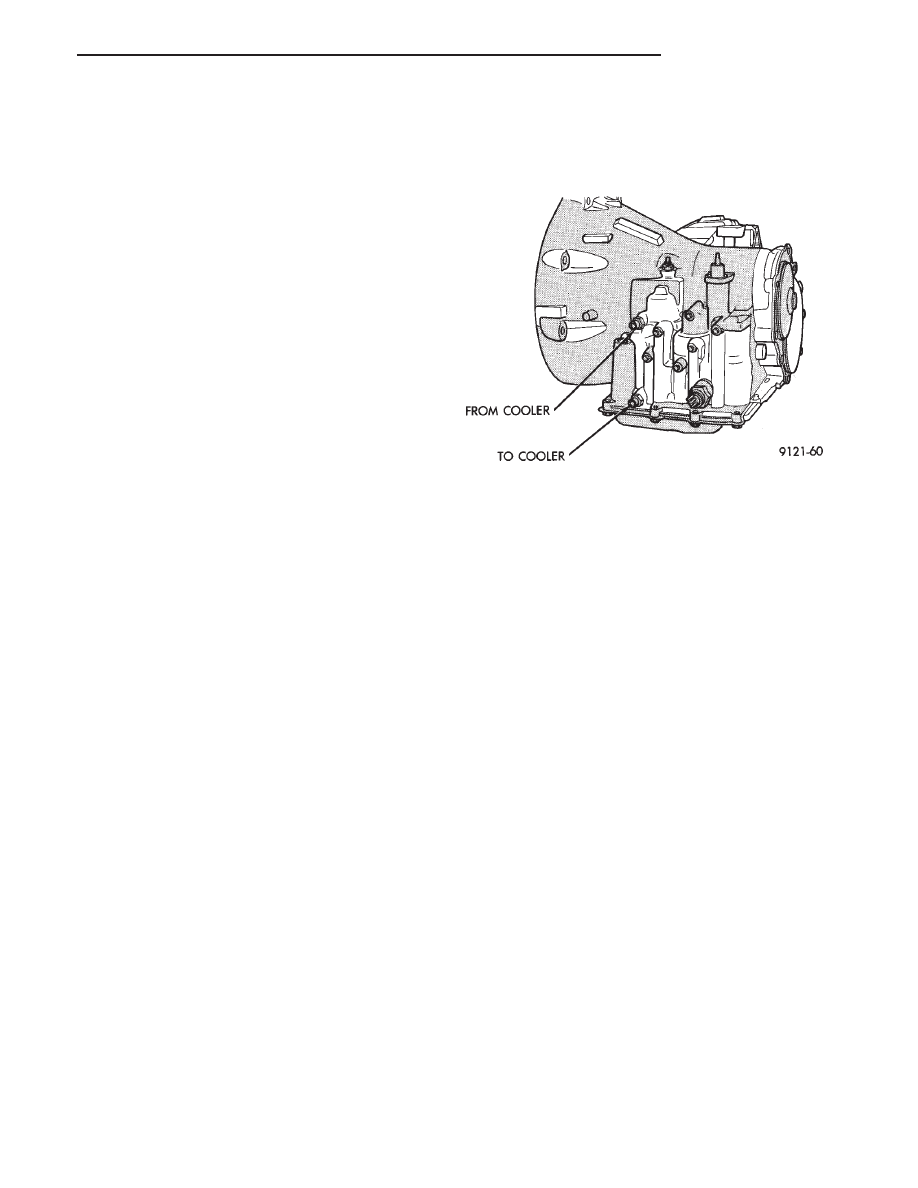Chrysler Town & Country/Voyager, Dodge Caravan, Plymouth Voyager. Manual - part 74

(4) Screw the switch with a new seal into transaxle
case and tighten to 33 N
Im (24 ft. lbs.). Retest switch
with the test lamp.
(5) Add fluid to transaxle to bring up to proper level.
(6) The back-up lamp switch circuit is through the
two outside terminals of the 3 terminal switch.
(7) To test switch, remove wiring connector from
switch and test for continuity between the two outside
pins.
(8) Continuity should exist only with transaxle in
Reverse position.
(9) No continuity should exist from either pin to the
case.
GOVERNOR
To service the governor assembly in the vehicle, it is
not necessary to remove the transfer gear cover, trans-
fer gear, and governor support. The governor may be
serviced by removing the transaxle oil pan and valve
body assembly. With the oil pan and valve body re-
moved, the governor may be unbolted from the gover-
nor support and removed from the transaxle for recon-
ditioning or replacement.
When cleaning or assembling the governor, make
sure the governor valves move freely in the bores of the
governor body.
ALUMINUM THREAD REPAIR
Damaged or worn threads in the aluminum tran-
saxle case and valve body can be repaired by the use of
Heli-Coils, or equivalent. This repair consists of drill-
ing out the worn-out damaged threads. Then tapping
the hole with a Heli-Coil tap, or equivalent, and install-
ing a Heli-Coil insert, or equivalent, into the hole. This
brings the hole back to its original thread size.
Heli-Coil, or equivalent, tools and inserts are readily
available from most automotive parts suppliers.
OIL COOLERS AND TUBES REVERSE FLUSHING
When a transaxle failure has contaminated the fluid,
the oil cooler(s) must be flushed and the cooler bypass
valve in the transaxle must be replaced. The torque
converter must also be replaced with an exchange unit.
This will insure that metal particles or sludged oil are
not transferred back into the reconditioned (or re-
placed) transaxle.
CAUTION: If vehicle is equipped with two oil coolers
(one in the radiator tank, one in front of the radiator)
they must be flushed separately. Do not attempt to
flush both coolers at one time.
(1) Disconnect the cooler lines at the transmission.
(2) Using a hand suction gun filled with mineral
spirits, reverse flush the cooler by forcing mineral
spirits into the From Cooler line of the cooler (Fig. 1).
Catch the exiting spirits from the To Cooler line.
Observe for the presence of debris in the exiting fluid.
Continue until fluid exiting is clear and free from
debris.
(3) Using compressed air in intermittent spurts,
blow any remaining mineral spirits from the cooler,
again in the reverse direction.
(4) To remove any remaining mineral spirits from
the cooler, one (1) quart of automatic transmission fluid
should be pumped through the cooler before reconnect-
ing.
(5) If at any stage of the cleaning process, the cooler
does not freely pass fluid, the cooler must be replaced.
OIL COOLER FLOW CHECK
After the new or repaired transmission has been
installed and filled to the proper level with automatic
transmission fluid, the flow should be checked using
the following procedure:
(1) Disconnect the From cooler line at the trans-
mission and place a collecting container under the
disconnected line.
(2) Run the engine at curb idle speed, with the
shift selector in neutral.
(3) If the fluid flow is intermittent or it takes more
than 20 seconds to collect one quart of automatic
transmission fluid, the cooler should be replaced.
CAUTION: With the fluid set at the proper level, fluid
collection should not exceed (1) quart or internal
damage to the transmission may occur.
(4) If flow is found to be within acceptable limits,
reconnect the cooler line and fill transmission to the
proper level, using the approved type of automatic
transmission fluid.
Fig. 1 Cooler Line Identification
.
TRANSAXLE
21 - 45